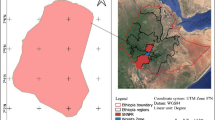Abstract
Simulated composite sampling was carried out using data from a contaminated site. The values obtained by composite sampling were compared with the results obtained using discrete (individual) samples. It is appropriate to use a modified investigation level (MIL) when using composite samples. The MIL is lower than the standard investigation level, (IL). Various MILs were considered in this study. Too low an MIL will indicate that some composite samples require further investigation, when none of the discrete samples comprising the composite would have exceeded the IL. Too high an MIL will result in some discrete samples that exceed the IL being missed. A suggested MIL is IL/\(\sqrt n \) where n is the number of discrete samples in the composite sample. This MIL was found to give few false negatives but many fewer false positives than the IL/n rule. Although this MIL was effective on the test data it could be site specific. Some local areas of high concentration may be missed with composite samples if a lower investigation level is used. These however do not make a large contribution to the health risk because they will have a contaminant level only slightly higher than the IL, and the neighboring samples must have a low concentration of the contaminant. The increased risk due this cause may be more than offset by the higher sampling density made possible through the economies of composite sampling When composite sampling is used as the first phase of an adaptive cluster-sampling scheme, it must be augmented by additional samples to delineate the contaminated area to be cleaned up. Composite sampling can also be effectively used in a “clean up unit” technique, where a clean up unit is represented by one or more composite samples. Suggestions are given for when composite sampling can be used effectively.
Similar content being viewed by others
References
ANZECC. (1992) Australian and New Zealand Guidelines for the Assessment and Management of Contaminated Sites, Australian and New Zealand Conservation Council/National Health and Medical Research Council.
EPA. (1995) EPA Observational Economy Series Volume 1: Composite Sampling, EPA-230-R-95-005. 401 M Street SW, Washington, DC 20460.
Exner, H.J., Keffer, W.D., Gilbert, R.O., and Kinnison, R.R. (1985) A sampling strategy for remedial action at Hazardous Waste Sites: Clean up of soil containing tetrachlorodibenzo-p-diaoxin. Hazardous Waste and Hazardous Materials, 2, 503-21.
James, D.W. and Wells, K.L. (1990) Soil Testing and Plant Analysis, 3rd ed., Chapter 3, SSSA Book Series, no. 3. Soil Science Society of America, Madison, WI.
Jones, K.C., Davies, B.E., and Peterson, P.J. (1986) Silver in Welsh soils: Physical and chemical distribution studies. Geoderma, 37, 157-74.
Lamé, F.P.J. and Defize, P.R. (1993) Sampling of contaminated soil: Soil sampling error in relation to sample size and segregation. Environmental Science and Technology, 27, 2035-44.
Laslett, G.M. (2000) Composite sampling of contaminated sites. Environmental and Ecological Statistics (in press).
Neptune, D., Brantly, E.P., Messner, M.J., and Michael, D.I. (1990) Quality decision making in superfund: A data quality objectives case study. Hazardous Materials Control, 3(3), 18-27.
Patil, G.P., Gore, S.D. and Johnson, G.D. (1966) EPA Observational Economy Series Volume 3, Manual on Statistical Design and Analysis with Composite Samples. PennState Center for Statistical Ecology and Environmental Statistics, Technical Report Number 96-0501.
Piper, C.S. (1942) Soil and Plant Analysis, Chapter 1, The University of Adelaide, Adelaide, 368 pp.
Ramsey, M.H., Argyraki, A., and Thompson, M. (1995) Estimation of sampling bias between different sampling protocols on contaminated land. Analyst, 120, 1353-56.
Rohlf, F.J., Akcakaya, H.R., and Ferraro, S.P. (1996) Optimizing composite sampling protocols. Environmental Science and Technology, 30, 2899-2905.
Ryti, R.T. and Neptune, D. (1991) Planning issues for super fund site remediation. Hazardous Materials Control, 4(6), 47-53.
Thomspon, S.K. (1996) Adaptive cluster sampling based order statistics. Environmetrics, 7, 123-33.
Williams, L.R., Leggett, R.W., Espegren, M.L., and Little, C.A. (1989) Optimization of sampling for the determination of mean Radium-226 concentration in surface soil. Environmental Monitoring and Assessment, 12, 83-96.
Author information
Authors and Affiliations
Rights and permissions
About this article
Cite this article
Correll, R.L. The use of composite sampling in contaminated sites—a case study. Environmental and Ecological Statistics 8, 185–200 (2001). https://doi.org/10.1023/A:1011395422397
Issue Date:
DOI: https://doi.org/10.1023/A:1011395422397




